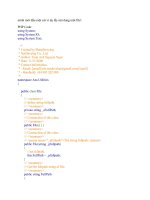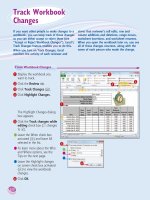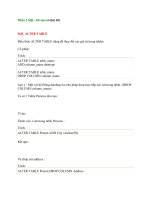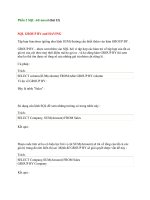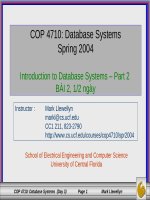Tài liệu Database Systems - Part 14 pdf
Bạn đang xem bản rút gọn của tài liệu. Xem và tải ngay bản đầy đủ của tài liệu tại đây (818.93 KB, 60 trang )
COP 4710: Database Systems (Day 18) Page 1 Mark Llewellyn
COP 4710: Database Systems
Spring 2004
Introduction to SQL – Part 2
BÀI 14, 2 ngày
COP 4710: Database Systems
Spring 2004
Introduction to SQL – Part 2
BÀI 14, 2 ngày
School of Electrical Engineering and Computer Science
University of Central Florida
Instructor : Mark Llewellyn
CC1 211, 823-2790
/>COP 4710: Database Systems (Day 18) Page 2 Mark Llewellyn
An Example Database(+)
COP 4710: Database Systems (Day 18) Page 3 Mark Llewellyn
Special Operators in SQL
•
ANSI standard SQL allows the use of special operators in
conjunction with the WHERE clause. These special
operators (see Day 17, page26) include:
BETWEEN – Used to check whether an attribute value is within a
range.
IS NULL – Used to determine if an attribute value is null.
LIKE – Used to match an attribute value to a string pattern. Many
wildcard options are available.
IN – Used to determine if an attribute value is within a list of values.
EXISTS – Used to determine if a subquery returns an empty set or
not.
COP 4710: Database Systems (Day 18) Page 4 Mark Llewellyn
The BETWEEN Special Operator(+)
•
Suppose that we want to see a listing for all products whose
prices are between $50 and $100. The BETWEEN operator
can be used for this query expression.
•
If your RDBMS does not support BETWEEN you would
need to express this query as:
SELECT *
FROM PRODUCT
WHERE P_PRICE BETWEEN 50.00 AND 100.00;
SELECT *
FROM PRODUCT
WHERE P_PRICE > 50.00 AND P_PRICE < 100.00;
COP 4710: Database Systems (Day 18) Page 5 Mark Llewellyn
The IS NULL Special Operator(+)
•
Suppose that we want to see a listing for all products that do
not currently have a vendor assigned, i.e., V_CODE = null.
The null entries could be found with the following query
expression.
•
NOTE: SQL uses a special operator for testing for nulls.
You cannot use a condition such as V_CODE = NULL. The
reason is that NULL is technically not a “value”, but a
special property of an attribute that represents precisely the
absence of any value at all.
SELECT P_CODE, P_DESCRIPT, V_CODE
FROM PRODUCT
WHERE V_CODE IS NULL;
COP 4710: Database Systems (Day 18) Page 6 Mark Llewellyn
The LIKE Special Operator(+)
•
The LIKE special operator is used in conjunction with
wildcards to find patterns within string attributes.
•
Standard SQL allows you to use the percent sign (%) and
underscore (_) wildcard characters to make matches when
the entire string is not known.
% means any and all following characters are eligible.
‘M%’ includes Mark, Marci, M-234x, etc.
_ means any one character may be substituted for the underscore.
‘_07-345-887_’ includes 407-345-8871, 007-345-8875
•
Note: Access uses * instead of % and ? instead of _. Oracle
searches are case-sensitive, Access searches are not.
COP 4710: Database Systems (Day 18) Page 7 Mark Llewellyn
The LIKE Special Operator (cont.)(+)
•
Suppose that we would like to find all the VENDOR rows
for contacts whose last names begin with Smith.
SELECT V_NAME, V_CONTACT, V_AREACODE, V_PHONE
FROM VENDOR
WHERE V_CONTACT LIKE ‘Smith%’;
COP 4710: Database Systems (Day 18) Page 8 Mark Llewellyn
The IN Special Operator(+)
•
Many queries that would seem to require the use of the
logical OR operator can be more easily handled with the help
of the special operator IN.
•
For example the query:
can be handled more efficiently with:
SELECT *
FROM PRODUCT
WHERE V_CODE = 21344 OR V_CODE = 24288;
SELECT *
FROM PRODUCT
WHERE V_CODE IN (21344, 24288);
COP 4710: Database Systems (Day 18) Page 9 Mark Llewellyn
The IN Special Operator (cont.)(+)
•
The IN operator is especially valuable when it is used in conjunction
with subqueries.
•
For example, suppose you want to list the V_CODE and V_NAME of
only those vendors that actually provide products. In this case, you
could use a subquery within the IN operator to automatically generate the
value list. The query expression would be:
•
We’ll look more closely at the IN operator later when we deal more in
depth with subqueries.
SELECT V_CODE, V_NAME
FROM VENDOR
WHERE V_CODE IN ( SELECT V_CODE
FROM PRODUCT);
COP 4710: Database Systems (Day 18) Page 10 Mark Llewellyn
The EXISTS Special Operator(+)
•
The EXISTS operator can be sued whenever there is a
requirement to execute a command based on the result of
another query. That is, if a subquery returns any rows, then
run the main query, otherwise, don’t. We’ll see this operator
in more detail when we look at subqueries in more depth.
•
For example, suppose we want a listing of vendors, but only
if there are products to order. The following query will
accomplish our task.
SELECT *
FROM VENDOR
WHERE EXISTS ( SELECT *
FROM PRODUCT
WHERE P_ONHAND <= P_MIN);
COP 4710: Database Systems (Day 18) Page 11 Mark Llewellyn
Virtual Tables: Creating Views
•
Recall that the output of a relational operator (like SELECT in SQL) is
another relations (or table).
•
Using our sample database as an example, suppose that at the end of each
business day, we would like to get a list of all products to reorder, which is
the set of all products whose quantity on hand is less than some threshold
value (minimum quantity).
•
Rather than typing the same query at the end of every day, wouldn’t it be
better to permanently save that query in the database?
•
To do this is the function of a relational view. In SQL a view is a table based
on a SELECT query. That query can contain columns, computed columns,
aliases, and aggregate functions from one or more tables.
•
The tables on which the view is based are called base tables.
•
Views are created in SQL using the CREATE VIEW command.
COP 4710: Database Systems (Day 18) Page 12 Mark Llewellyn
Virtual Tables: Creating Views (cont.)
•
The syntax of the CREATE VIEW command is:
•
The CREATE VIEW statement is a DDL command that stores the
subquery specification, i.e., the SELECT statement used to generate the
virtual table in the data dictionary.
•
An example:
•
Note: The CREATE VIEW command is not directly supported in
Access. To create a view in Access, you just need to create an SQL
query and then save it.
viewname query
!"#""$
COP 4710: Database Systems (Day 18) Page 13 Mark Llewellyn
Virtual Tables: Creating Views (cont.)
•
A relational view has several special characteristics:
1. You can use the name of a view anywhere a table name is expected in an SQL
statement.
2. Views are dynamically updated. That is, the view is re-created on demand
each time it is invoked.
3. Views provide a level of security in the database because the view can restrict
users to only specified columns and specified rows in a table.
4. Views may also be used as the basis for reports. The view definition shown
below creates a summary of total product cost and quantity on hand statistics
grouped by vendor:
%
&'(
%&(%)*&(
)*
+&(+)*
+,*$
COP 4710: Database Systems (Day 18) Page 14 Mark Llewellyn
Joining Database Tables
•
The ability to combine (join) tables on common attributes is perhaps the
most important distinction between a relational database and other types
of databases.
•
In SQL, a join is performed whenever data is retrieved from more than
one table at a time.
•
To join tables, you simply enumerate the tables in the FROM clause of
the SELECT statement. The RDBMS will create the Cartesian product
of every table specified in the FROM clause.
•
To effect a natural join, you must specify the linking on the common
attributes in the WHERE clause. This is called the join condition.
•
The join condition is generally composed of an equality comparison
between the foreign key and the primary key in the related tables.
COP 4710: Database Systems (Day 18) Page 15 Mark Llewellyn
Joining Database Tables (cont.)(+)
•
Suppose we want to join the VENDOR and PRODUCT tables.
V_CODE is the foreign key in the PRODUCT table and the primary key
in the VENDOR table, the join condition occurs on this attribute.
###
###
#-#$
)./
01
0213203
4.5
651
667.6
880
1265020
2965:20
620#
COP 4710: Database Systems (Day 18) Page 16 Mark Llewellyn
Joining Database Tables (cont.)
•
If you do not specify a join condition in the WHERE clause, a Cartesian
product results. Using our sample database, the PRODUCT table
contains 16 tuples (rows) and the VENDOR table contains 11 tuples,
which results in a Cartesian product that contains 16 × 11 = 176 tuples.
Most of these tuples (as you can see from the proper result on the
previous page) are garbage!
•
When joining three or more tables, you need to specify a join condition
for each pair of tables. The number of join conditions will always be N-
1 where N is the number of tables listed in the FROM clause.
•
Be careful not to create circular join conditions. For example, if table A
is related to table B, table B is related to table C, and table C is also
related to table A, create only two join conditions: join A with B and B
with C. Do not join C with A!
COP 4710: Database Systems (Day 18) Page 17 Mark Llewellyn
Recursive Joins
•
An alias can be used to identify the source table from which data is taken
for a query. For example:
•
An alias is especially useful when a table must be joined with itself,
called a recursive join.
•
For example, using the EMPLOYEE table we would like to generate a
list of all employees along with the name of their manager. Without
using an alias this query is not possible, since even qualified attribute
names are not unique.
#-#
,*$
60; 0 # 0
65
<3279265
#
COP 4710: Database Systems (Day 18) Page 18 Mark Llewellyn
Recursive Joins (cont.)(+)
60; 0
.0;026620#
COP 4710: Database Systems (Day 18) Page 19 Mark Llewellyn
Outer Joins
•
The query results shown on page 23 resulted from the natural join of the
PRODUCT and VENDOR tables. Notice that there are 14 product rows
listed in this output. If you compare these results with the PRODUCT
table itself (see Day 17 page 45) you will notice that there are two missing
products. Why? The reason is that the two missing products have null
values in the V_CODE attribute in the PRODUCT table. Because there is
no matching null “value” in the VENDOR table’s V_CODE attribute, they
do not appear in the final output based on the join.
•
To include such rows in the final join output, we’ll need to use an outer
join.
•
Recall that there are three basic types of outer joins, left outer joins, right
outer joins, and full outer joins. Given tables A and B, A left outer join B
gives all matching rows (on the join condition) plus all unmatched rows in
A. A right outer join B gives all matching rows (on the join condition)
plus all unmatched rows in B. We’ll look at full outer joins later.
COP 4710: Database Systems (Day 18) Page 20 Mark Llewellyn
Left Outer Joins(+)
•
To include the null valued V_CODE
tuples from the PRODUCT table in the
final output, we’ll need to issue the
following query:
26=52>2.6?2026
880654.3#618365
96:202;56:20652.6
18#
COP 4710: Database Systems (Day 18) Page 21 Mark Llewellyn
Left Outer Joins (cont.) (+)
.652292165
1650;2921&962.6
:20(#
COP 4710: Database Systems (Day 18) Page 22 Mark Llewellyn
Right Outer Joins (+)
•
The VENDOR table is shown below. Notice that there are rows in
this table in which the V_CODE does not match any of the V_CODE
values in the PRODUCT table.
5
@022
02688
065
67
COP 4710: Database Systems (Day 18) Page 23 Mark Llewellyn
Right Outer Joins (cont.) (+)
5;562.6:2052
2651650;
2#
COP 4710: Database Systems (Day 18) Page 24 Mark Llewellyn
Right Outer Joins (cont.) (+)
.6522921
651650;2921
&;562.6:20(
COP 4710: Database Systems (Day 18) Page 25 Mark Llewellyn
Relational Set Operators
•
Recall that relational algebra is set-oriented and includes many set
operators such as union, intersection, and set difference. Recall too, that
the terms, sets, tables and relations are interchangeable in the relational
world.
•
As with pure relational algebra, the set operators only work with union-
compatible relations. In SQL, this means that the names of the attributes
must be the same and their data types must be identical. This is an area
where different RDBMSs vary widely in what is meant by union-
compatible. For example, some RDBMSs will consider the data types
VARCHAR(35) and VARCHAR(15) compatible because, although they
have different length, the underlying base type is the same. Other
RDBMSs will not consider these two data types as compatible. You’ll
need to experiment with your RDBMS to see what is compatible and
what isn’t.



